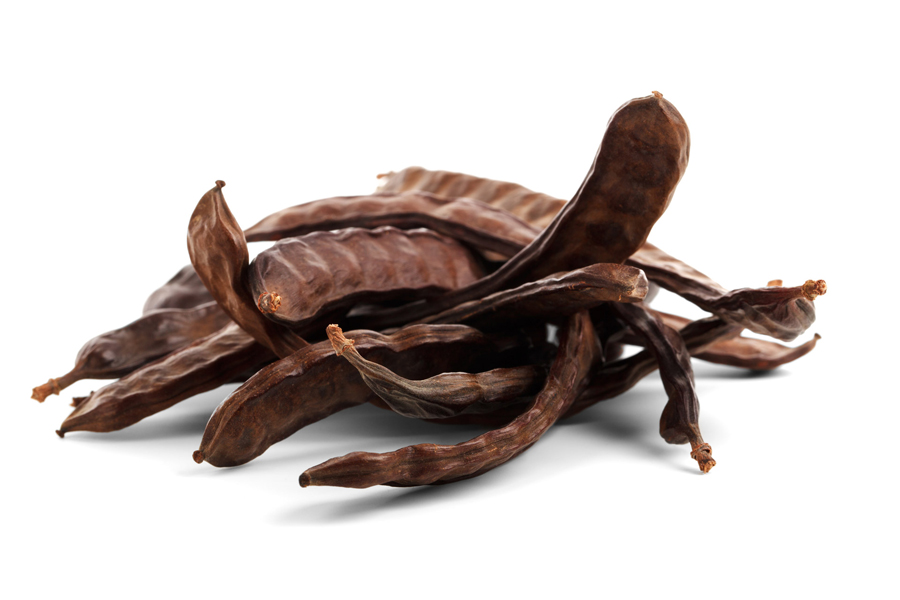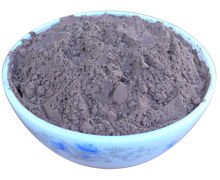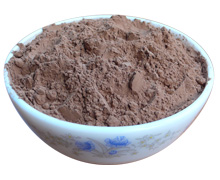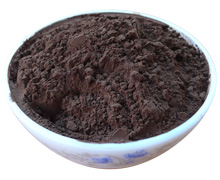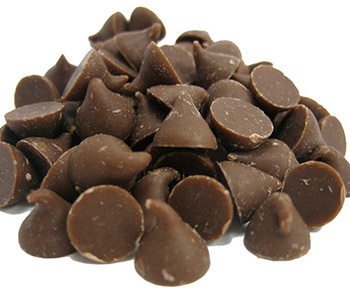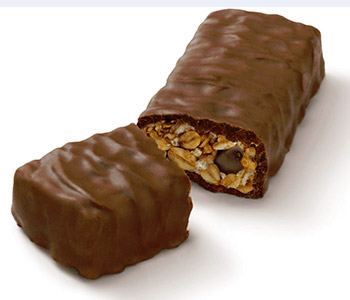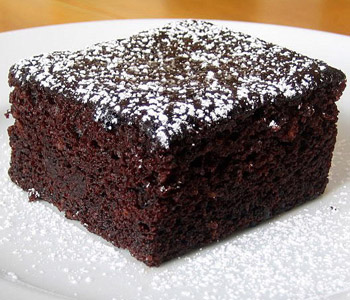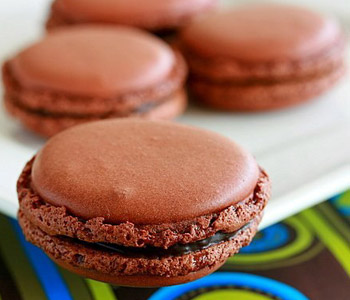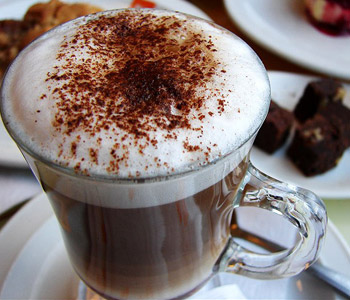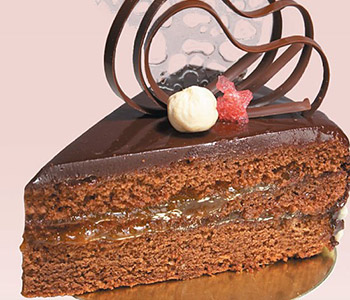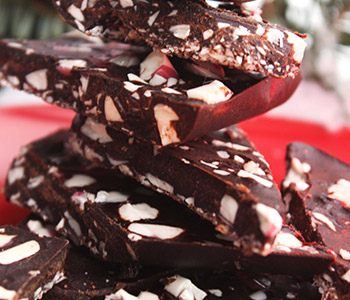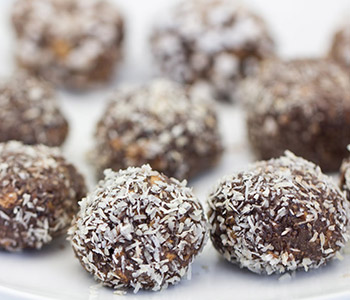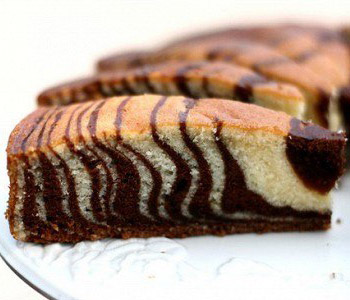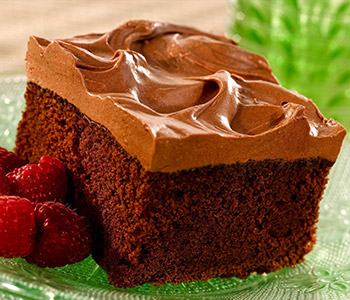Powder from carob fruits (pods)
The natural sweet taste of Carob (sweetness is 0.50-0.60 from the sweetness of sugar) allows you to use less sugar in the final product.
Unlike cocoa beans, carob is sweet by itself and does not require the addition of refined sugar when preparing sweets.
Contains a rich set of vitamins and minerals. The carob contains vitamins A, B, B2, D and 8% of it is protein. It contains a lot of calcium, phosphorus, potassium, magnesium, iron, copper, nickel, barium and manganese.
Carob significantly reduces the absorption of excess cholesterol in daily meals. Its hypocholesteric ability is twice as strong as that of other dietary fibers.
Unlike coffee and cocoa, the kerob does not contain psychotropic substances: caffeine and theobromine, which are in chocolate and which are addictive and allergic.
Pharmacological properties of carob
Carob is interesting not only as a treat, but also because of its numerous therapeutic and prophylactic properties, which put it in a row of functionally important food products. We will briefly list some of them:
- improvement of digestion, treatment of gastrointestinal disorders;
- like other products containing insoluble dietary fiber and phenolic antioxidants, reduces the levels of "bad" cholesterol-low-density lipoproteins in blood;
- has anti-carcinogenic and antitumoral effect in relation to various types of tumors;
- regular consumption of carob prevents or inhibits the development of lung cancer in smokers;
- antioxidant effect, including induction of antioxidant protection enzymes - superoxide dismutase, catalase, paroxanase - enzyme for detoxification of pesticides and other non-natural toxic substances;
- antibacterial, antiparasitic, fungicidal action;
- causes a sense of satiety, helps to reduce body weight by losing fat tissue;
- has a calming effect on the nervous system (from extracts of leaves and pods isolated compounds interacting with central and peripheral benzdiazepine receptors).
Chemical composition of carob
| Ingridients | % |
|---|---|
| Total amount of sugars | 48-56 |
| Sucrose | 32-38 |
| Glucose | 5-6 |
| Fructose | 5-7 |
| Pinitol | 5-7 | Condensed tannins | 18-20 | Polysaccharides | 18 | Ash (mineral elements) | 2-3 | Fats | 0,2-0,6 |
It is obvious that the numerous medicinal properties of carob are due to its unique chemical composition. Carob fruits are divided into two components: pods with pulp (further pods) and proper seeds, which are 90 and 10% by weight, respectively. The chemical composition of the pods depends somewhat on the place of growth, the time of collection, the method of cultivation and processing, but on average can be characterized as follows (see Table 1).
Most of the carob pulp is made up of sugars (48-56%), mainly sucrose, glucose, fructose and maltose, plus 18% cellulose and hemicellulose. The pods contain a little of protein - 3-8% of the dry weight, but there is an almost complete set of free amino acids, including irreplaceable ones. A distinctive feature is the high content of arginine.
The mineral composition is also worth noticing: K = 1100, Ca = 307, Mg = 42, Na = 13, Cu = 0.23, Fe = 104, Mn = 0.4, Zn = 0.59 (in mg per 100 g of pod mass). The fat content is insignificant: 0.2-0.6%. Vitamins A, E, group B are noted.
Carob contains no phenyltylamine, which causes a migraine, and aromamine, which in addition to migraines causes allergies.
Carob contains no oxalic acid, which prevents the body from using calcium and zinc. These minerals (calcium and zinc) are essential for healthy skin. The presence of oxalic acid in chocolate can be the cause of acne, which usually appears in adolescents prone to excessive consumption of chocolate.
Carob contains large carbohydrates (sugars) and tannins. Carbohydrates make carob sticky and able to absorb water and act as a thickener. Tannins bind toxins, thus deactivating them.
However, the overall chemical composition of carob shows little about its unique pharmacological properties, which are also determined by its "minor compounds". Let's consider some of them:
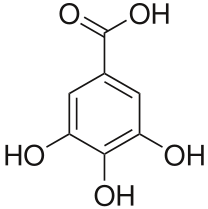 Carob extracts are rich in tannins, which determines, in particular, its effectiveness in diarrhea. Hydrolysable and non-hydrolysable tannins are composed mainly of gallic acid residues and its derivatives. Gallic acid is found in carob extracts and in free form. This low molecular weight compound has been very well studied, as it has found in pharmacology many applications both in unchanged form and as a precursor for many pharmacologically significant substances. Apparently, the most developed now are the antitumor properties of gallic acid and its derivatives, proven both on the cultured cell lines of various tumors, and in animals and humans. In many plants that have antitumor actions, it was precisely gallic acid that was identified as the active principle. In addition to antitumor activity, gallic acid has antibacterial, antiviral, antioxidant action, prevents the development of poliomyelitis in children, suppresses the rubella virus, has an analgesic effect and is effective in various sepsis. In recent years, considerable attention has been paid to the possibility of using gallic acid for the treatment and prevention of neurodegenerative diseases, including Alzheimer's disease.
Carob extracts are rich in tannins, which determines, in particular, its effectiveness in diarrhea. Hydrolysable and non-hydrolysable tannins are composed mainly of gallic acid residues and its derivatives. Gallic acid is found in carob extracts and in free form. This low molecular weight compound has been very well studied, as it has found in pharmacology many applications both in unchanged form and as a precursor for many pharmacologically significant substances. Apparently, the most developed now are the antitumor properties of gallic acid and its derivatives, proven both on the cultured cell lines of various tumors, and in animals and humans. In many plants that have antitumor actions, it was precisely gallic acid that was identified as the active principle. In addition to antitumor activity, gallic acid has antibacterial, antiviral, antioxidant action, prevents the development of poliomyelitis in children, suppresses the rubella virus, has an analgesic effect and is effective in various sepsis. In recent years, considerable attention has been paid to the possibility of using gallic acid for the treatment and prevention of neurodegenerative diseases, including Alzheimer's disease.
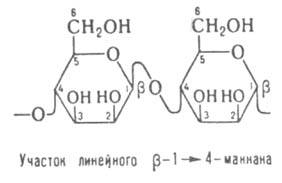 A special word should be said about galactomannans, which are heteropolysaccharides consisting of galactose and mannose residues. These polysaccharides are able to bind a lot of water (swell) - 17 times more than their own weight. Therefore, galactomannans are widely used in the food industry as stabilizers, thickeners and gelling agents in the production of mayonnaise, sauces, dairy products, ice cream, etc. In the list of food additives (E410-E499), galactomannans of carob were given the number E410. For us, from a pharmacological point of view, it is important that galactomannans are removed from the intestine in an unchanged form, taking various toxins, heavy metals, oxidized cholesterol, products of cellular degradation, i.e. represent the most vital non-hydrolysable dietary fiber, which has been talked about so much in recent years. An interesting property of the carotene gallantomannans is the ability to reduce the content of one of the peptides that determine the feeling of hunger - ghrelin. Thus, the carob's property of causing a feeling of satiety was explained not only by the fact that the polysaccharides swell and fill the stomach, but also in direct influence on the peptides that regulate this condition.
A special word should be said about galactomannans, which are heteropolysaccharides consisting of galactose and mannose residues. These polysaccharides are able to bind a lot of water (swell) - 17 times more than their own weight. Therefore, galactomannans are widely used in the food industry as stabilizers, thickeners and gelling agents in the production of mayonnaise, sauces, dairy products, ice cream, etc. In the list of food additives (E410-E499), galactomannans of carob were given the number E410. For us, from a pharmacological point of view, it is important that galactomannans are removed from the intestine in an unchanged form, taking various toxins, heavy metals, oxidized cholesterol, products of cellular degradation, i.e. represent the most vital non-hydrolysable dietary fiber, which has been talked about so much in recent years. An interesting property of the carotene gallantomannans is the ability to reduce the content of one of the peptides that determine the feeling of hunger - ghrelin. Thus, the carob's property of causing a feeling of satiety was explained not only by the fact that the polysaccharides swell and fill the stomach, but also in direct influence on the peptides that regulate this condition.
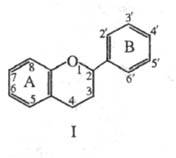 With this class of compounds, antioxidant properties are associated with various plants. Antioxidants are compounds that extinguish various free radicals and peroxides that accompany almost all diseases and are the cause of many of them, including cancer. With the antioxidant insufficiency of the body, not only the course of many diseases is aggravated, but there is an accelerated aging of the organism. Carob extracts contain many different polyphenols (3.94 g / kg dry weight). At present, there are 24 different proliphenol compounds in carob. Even more "volatile oils" - 169 different compounds. A detailed study of the chemical composition and pharmacology of carob and its individual ingredients, observed in recent years, shows of how much interest this is, commonly used as a substitute for chocolate, and more recently as a source of pharmacologically active compounds, an ancient plant.
With this class of compounds, antioxidant properties are associated with various plants. Antioxidants are compounds that extinguish various free radicals and peroxides that accompany almost all diseases and are the cause of many of them, including cancer. With the antioxidant insufficiency of the body, not only the course of many diseases is aggravated, but there is an accelerated aging of the organism. Carob extracts contain many different polyphenols (3.94 g / kg dry weight). At present, there are 24 different proliphenol compounds in carob. Even more "volatile oils" - 169 different compounds. A detailed study of the chemical composition and pharmacology of carob and its individual ingredients, observed in recent years, shows of how much interest this is, commonly used as a substitute for chocolate, and more recently as a source of pharmacologically active compounds, an ancient plant.
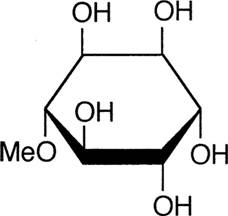 Pinitol (3-O-methyl-D-chiro-inositol) isolated from soy is well studied. The compound has antioxidant activity, hepatoprotective and antiatherogenic (antisclerotic) effect even in cholesterol-enriched diets, it increases the content of useful high-density lipoproteins, adiponectin (which is associated with a reduction in the risk of cardiovascular diseases), increases the activity of the enzyme against organic peroxides-paroxanase and, on the contrary , suppresses the activity of a number of enzymes for the conversion of fats, reduces fatty degeneration of the liver, is recommended for use to people with diabetes and Alzheimer's disease.
Pinitol (3-O-methyl-D-chiro-inositol) isolated from soy is well studied. The compound has antioxidant activity, hepatoprotective and antiatherogenic (antisclerotic) effect even in cholesterol-enriched diets, it increases the content of useful high-density lipoproteins, adiponectin (which is associated with a reduction in the risk of cardiovascular diseases), increases the activity of the enzyme against organic peroxides-paroxanase and, on the contrary , suppresses the activity of a number of enzymes for the conversion of fats, reduces fatty degeneration of the liver, is recommended for use to people with diabetes and Alzheimer's disease.
Carob powder is an ideal substitute for cocoa and sugar in chocolate and confectionery recipes, not only due to acceptable cost characteristics, but also organoleptic properties.
Carob powder is used in the production of both dark and white glazes, without changing the original color and smell of the final product.
Carob is a natural multivitamin complex that positively and systematically influences the state of health
Caffeine and theobromine are stimulants. Caffeine acts directly on the brain, stimulating feelings, inspiration and vigilance. Caffeine can be transmitted with breast milk, pregnant women are also advised to refrain from taking caffeine.
Caffeine has analgesic properties, but also has side effects: anxiety, nervousness, nausea and increased heart rate. It stimulates the production of gastric juice and acts as a diuretic, that is because of it, together with water, a leakage of water-soluble vitamins B and C can occur.
Caffeine stimulates the release of body energy reserves, that is, the supply of sugars sharply enters the bloodstream. You know what it leads to: diabetes, obesity, etc.
Carob powder is safe
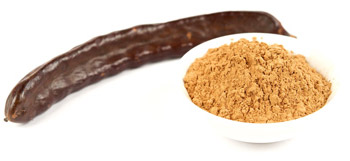
Carob powder is a widely consumed product in the world. Carob is fed even to newborns in the treatment of diarrhea and to reduce the frequency of regurgitation. Intensive studies of carob did not reveal a carcinogenic and toxic effect. There are still no reports of the risk of using carob during pregnancy and lactation.
According to the report of the US Food and Drug Administration (FDA), consumption of carob is safe for humans and animals, belongs to the class GRAS - Generally recognized as safe.
Carob dosage
There are no recommended doses for various gingerbread, biscuits, and cakes containing a carob. There is no danger of an overdose of carob powder.

